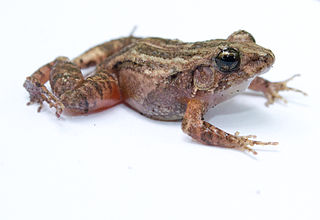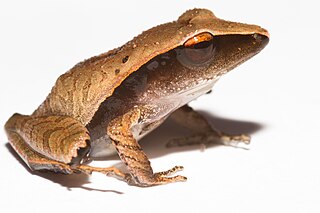Craugastor anciano was a species of frog in the family Craugastoridae. It was endemic to the Cordillera de Celaque in Honduras. Its natural habitats were moist premontane and lower montane forests. It lived on the ground along streams.

Craugastor augusti is a species of frog in the family Craugastoridae found in Mexico and the southern United States. It is known by various common names but most commonly as the barking frog. The nominal species likely includes more than one species, sometimes described as subspecies such as the common barking frog, western barking frog, and eastern barking frog. The epithet augusti is in honor of renowned French zoologist Auguste Duméril.
Craugastor bocourti is a species of frog in the family Craugastoridae. It is endemic to Guatemala and found on the mountains of the Alta Verapaz Department and the Sierra de las Minas. It is named after Marie Firmin Bocourt, a French zoologist and artist.

Craugastor bransfordii is a species of frog in the family Craugastoridae. It is found in Costa Rica, Nicaragua, and Panama. Its natural habitats are subtropical or tropical moist lowland forests and subtropical or tropical moist montane forests. It is threatened by habitat loss. Its conservation status in terms of IUCN Status is Least Concern (LC).

Craugastor gollmeri is a species of frog in the family Craugastoridae. It is found in Costa Rica and Panama. Its natural habitats are subtropical or tropical moist lowland forests, subtropical or tropical moist montane forests, rural gardens, and heavily degraded former forest. It is threatened by habitat loss.
Craugastor matudai is a species of frog in the family Craugastoridae. It is found in the lower montane zone at elevations of 1,500–2,000 m (4,900–6,600 ft) above sea level on the Pacific versant of Mexico and Guatemala, from Cerro Ovando in southwestern Chiapas (Mexico) to Fraternidad, a village in Esquipulas Palo Gordo, central Guatemala. It is named after Eizi Matuda, Japanese–Mexican botanist who hosted Hobart Muir Smith and his wife Rozella B. Smith, the collectors of the type series from Cerro Ovando.
Craugastor melanostictus is a species of frog in the family Craugastoridae. It is found in Costa Rica and Panama. Its natural habitat is subtropical or tropical moist montane forests. It is threatened by habitat loss.
Craugastor mexicanus is a species of frog in the family Craugastoridae. It is endemic to eastern Mexico and occurs in the states of Oaxaca, Puebla, Hidalgo, and Veracruz. It is a common species inhabiting tropical wet and semi-deciduous forest, pine-oak montane forest, and montane cloud forest at elevations of 700–3,420 m (2,300–11,220 ft) above sea level. Although it is adaptable to habitat disturbance, loss of cloud forest is a potential threat to it. Also chytridiomycosis can have negative impacts. It is present in a number of protected areas, including Cofre de Perote National Park, Tehuacán-Cuicatlán Biosphere Reserve, and Cuenca Hidrográfica Río Necaxa.

Craugastor noblei is a species of frog in the family Craugastoridae. It is found in Costa Rica, Honduras, Nicaragua, and Panama. Its natural habitat is subtropical or tropical moist lowland forests. It is threatened by habitat loss.
Gunther's robber frog, Günther's robber frog, or Guerreran robber frog is a species of frog in the family Craugastoridae. It is endemic to the Sierra Madre del Sur in the Mexican state of Guerrero. Its natural habitats are pine, oak, and pine-oak forests with plenty of leaf-litter on the ground. It is a relatively common species but declining and threatened by habitat loss and disturbance.
Craugastor omoaensis is a species of frog in the family Craugastoridae. It is endemic to Honduras and also is one of 13 species of amphibians and reptiles that are endemic to the Sierra de Omoa. It is known from only 24 specimens studied. Its natural habitats are subtropical or tropical moist montane forests, rivers, and intermittent rivers.
Craugastor palenque is a species of frogs in the family Craugastoridae.
Craugastor ranoides is a species of frog in the family Craugastoridae. It is found in the southern Atlantic lowland of Nicaragua and northwestern Costa Rica, and through Costa Rica to extreme western Panama. Its natural habitats are, principally, lowland and premontane wet forests in association with small streams, but also dry forests with perennial streams. It is threatened by habitat loss and chytridiomycosis. The species has disappeared from much of its former range in Costa Rica, also in pristine habitats, possibly because of chytridiomycosis.

Craugastor rhodopis, also known as the polymorphic robber frog, is a species of frog in the family Craugastoridae. It is endemic to Mexico and known from isolated high-elevation populations in western Veracruz and adjacent Hidalgo and Puebla states, and apparently disjunctly, from central and southeastern Chiapas and adjacent Oaxaca. Its natural habitat is tropical montane forest. It is threatened by habitat loss.
Craugastor sartori, also known as the Chiapas dwarf robber frog, is a species of frog in the family Craugastoridae. It is endemic to Mexico and known from the Sierra Madre de Chiapas in the vicinity of Cerro Ovando, at elevations of about 1,200–1,900 m (3,900–6,200 ft) asl. Its natural habitats are montane cloud and mixed forests. It is threatened by habitat loss caused by particularly logging.
Craugastor spatulatus is a species of frog in the family Craugastoridae. It is endemic to Mexico and known from Cuautlapam in central Veracruz and Vista Hermosa in the Sierra Juárez, Oaxaca. Its natural habitat is cloud forest. This formerly abundant species has strongly declined because of habitat loss, although other factors may have been involved too.
Craugastor talamancae is a species of frog in the family Craugastoridae. It is found in the Atlantic versant of Panama, Costa Rica, and southeastern Nicaragua. Common name Almirante robber frog has been proposed for it.
Craugastor taylori is a species of frog in the family Craugastoridae. It is endemic to Mexico and only known from its type locality near Rayón Mescalapa, Chiapas, in Southeast Mexico. Its common name is Taylor's robber frog. It is named in honour of Edward Harrison Taylor.
Craugastor xucanebi is a species of frog in the family Craugastoridae. It is endemic to Guatemala.
Craugastor laevissimus is a species of frog in the family Craugastoridae. It is found in Honduras and Nicaragua. Its natural habitats are lowland and sub-montane wet and moist forests; it can survive in degraded forest and secondary growth. It occurs along streams and small rivers.






